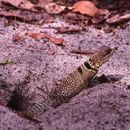ar
الأسماء في صفحات التنقل


Leguán madagaskarský (Oplurus cuvieri) je druh leguána, největší druh vyskytující se na Madagaskaru. V ČR jej chovají ZOO Plzeň a Zoo Brno.
Druh dosahuje 25-30 cm (maximálně 40 cm) a váží 2 kg. Živí se převážně hmyzem, zřídka pak plody a listy rostlin. Páření probíhá 3 týdny po zimním období. Samice klade 3 vejce, která zahrabává do lehce vlhkého substrátu; při inkubační teplotě 29 stupňů se mláďata líhnou za 70–75 dnů.
Vyskytuje se na západní části Madagaskaru a od centra ostrova až na hranici východního deštného pralesa. Obývá suché lesy, kde šplhá na větší větve stromů či hledá úkryt v dutinách kmenů; lze ho zastihnout také v otevřené krajině na skalách či na zemi.
V tomto článku byl použit překlad textu z článku Oplurus cuvieri na anglické Wikipedii.
Leguán madagaskarský (Oplurus cuvieri) je druh leguána, největší druh vyskytující se na Madagaskaru. V ČR jej chovají ZOO Plzeň a Zoo Brno.
Oplurus cuvieri, commonly known as the collared iguana, the collared iguanid lizard, Cuvier's Madagascar skink, Cuvier's Madagascar swift, and the Madagascan collared iguana, is a species of arboreal lizard in the family Opluridae. The species is native to Madagascar and Comoros. There are two recognized subspecies. O. cuvieri is the largest of six species in the genus Oplurus.
The specific name, cuvieri, is in honor of French naturalist Georges Cuvier.[3]
As some of the common names suggest, O. cuvieri has a distinctive black collar that stands out against the body which is speckled with lighter spots. It has a large head, and the relatively short tail has spiny scales. The female is a duller brown colour.[4]
The images below show considerable variation in markings and coloration.
At Tsimanampetsotsa National Park, showing a false eye on top of head
The collared iguana is found in the western tropical forests of Madagascar and on the island of Grand Comore in Comoros.[1]
Two subspecies are recognized as being valid, including the nominotypical subspecies.[2]
Nota bene: A trinomial authority in parentheses indicates that the subspecies was originally described in a genus other than Oplurus.
O. cuvieri has a mostly carnivorous diet.[4]
Breeding of O. cuvieri is timed with the rainy season.[4]
Oplurus cuvieri, commonly known as the collared iguana, the collared iguanid lizard, Cuvier's Madagascar skink, Cuvier's Madagascar swift, and the Madagascan collared iguana, is a species of arboreal lizard in the family Opluridae. The species is native to Madagascar and Comoros. There are two recognized subspecies. O. cuvieri is the largest of six species in the genus Oplurus.
Oplurus cuvieri o iguana de collar malgache es una especie de gecko de la familia Gekkonidae.[2] Es endémico de Gran Comora y Madagascar. En Gran Comora es amenazada por la caza y la captura para el comercio de mascotas exóticas.
Se reconocen las siguientes:[2]
Oplurus cuvieri o iguana de collar malgache es una especie de gecko de la familia Gekkonidae. Es endémico de Gran Comora y Madagascar. En Gran Comora es amenazada por la caza y la captura para el comercio de mascotas exóticas.
Oplurus cuvieri Oplurus generoko animalia da. Narrastien barruko Opluridae familian sailkatuta dago.
Oplurus cuvieri Oplurus generoko animalia da. Narrastien barruko Opluridae familian sailkatuta dago.
Oplurus cuvieri est une espèce de sauriens de la famille des Opluridae[1].
Cette espèce se rencontre[1] :
Ce lézard atteint au maximum 35 cm de long[1].
Selon Reptarium Reptile Database (27 février 2012)[2] :
Cette espèce est nommée en l'honneur de Georges Cuvier[3]. Le nom de la sous-espèce, composé de comor et du suffixe latin -ensis, « qui vit dans, qui habite », lui a été donné en référence au lieu de sa découverte, l'île de Grande Comore aux Comores.
L'iguana codaspinosa del Madagascar (Oplurus cuvieri Gray, 1831) è un sauro della famiglia Opluridae, endemico del Madagascar e delle isole Comore.[2]
L'epiteto specifico è un omaggio al naturalista francese George Cuvier (1769-1832).
È un sauro di medie dimensioni, che solitamente non supera i 40 cm di lunghezza.[3]
Ha una coda robusta, provvista di squame spinose, che utilizza come arma nei conflitti con i rivali.
Presenta un discreto dimorfismo sessuale: i maschi si differenziano dalle femmine per le maggiori dimensioni e per la presenza di una macchia giallastra in corrispondenza delle squame peri-anali, che può estendersi al ventre.[4]
Sono animali solitari, attivi durante le ore diurne. Sono prevalentemente arboricoli ma scendono occasionalmente sul terreno.
Hanno una dieta onnivora che comprende prevalentemente insetti e occasionalmente anche piccoli vertebrati; nella stagione delle piogge, periodo in cui le prede scarseggiano, diventano prevalentemente erbivori nutrendosi di foglie, germogli e semi.[5][6]
Trascorrono la maggior parte del tempo aggrappati ai rami degli alberi e tendono agguati fulminei alle prede che capitano loro a tiro[7].
È una specie ovipara; durante la stagione delle piogge la femmina scava una buca nel terreno nella quale depone depone da 2 a 5 uova che poi ricopre di terra.[8]
L'areale di questa specie comprende il Madagascar nord-occidentale e l'isola Grande Comore.[2] Il suo habitat tipico è la foresta decidua secca ma lo si può trovare anche nelle foreste transizionali e nelle aree coltivate.
Sono note due sottospecie:[2]
L'iguana codaspinosa del Madagascar (Oplurus cuvieri Gray, 1831) è un sauro della famiglia Opluridae, endemico del Madagascar e delle isole Comore.
L'epiteto specifico è un omaggio al naturalista francese George Cuvier (1769-1832).
Oplurus cuvieri là một loài thằn lằn trong họ Opluridae. Loài này được Gray mô tả khoa học đầu tiên năm 1831.[1]
Oplurus cuvieri là một loài thằn lằn trong họ Opluridae. Loài này được Gray mô tả khoa học đầu tiên năm 1831.